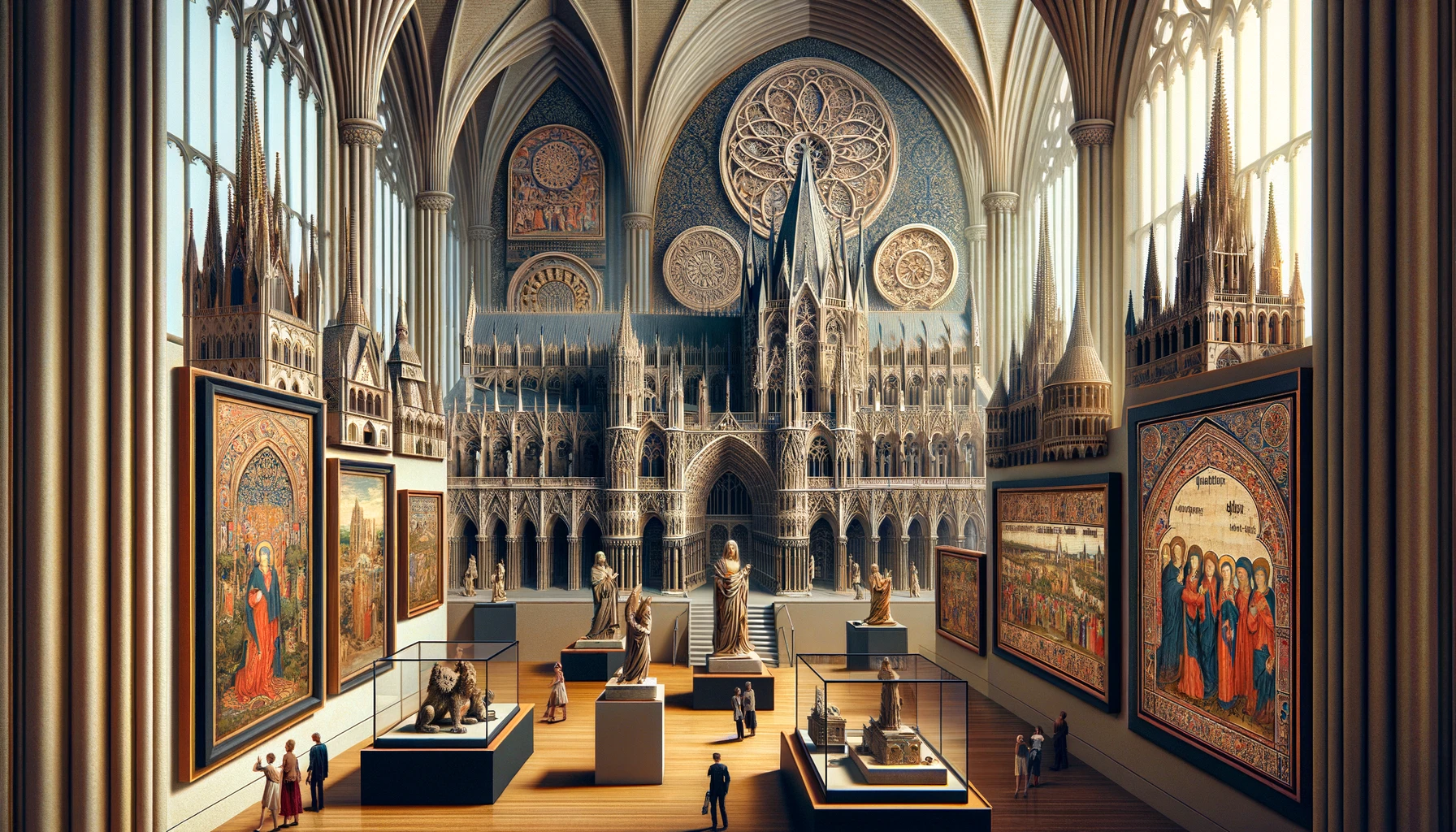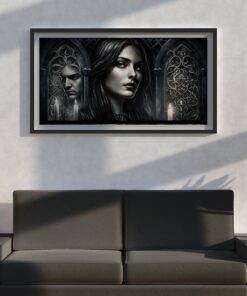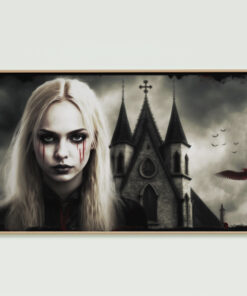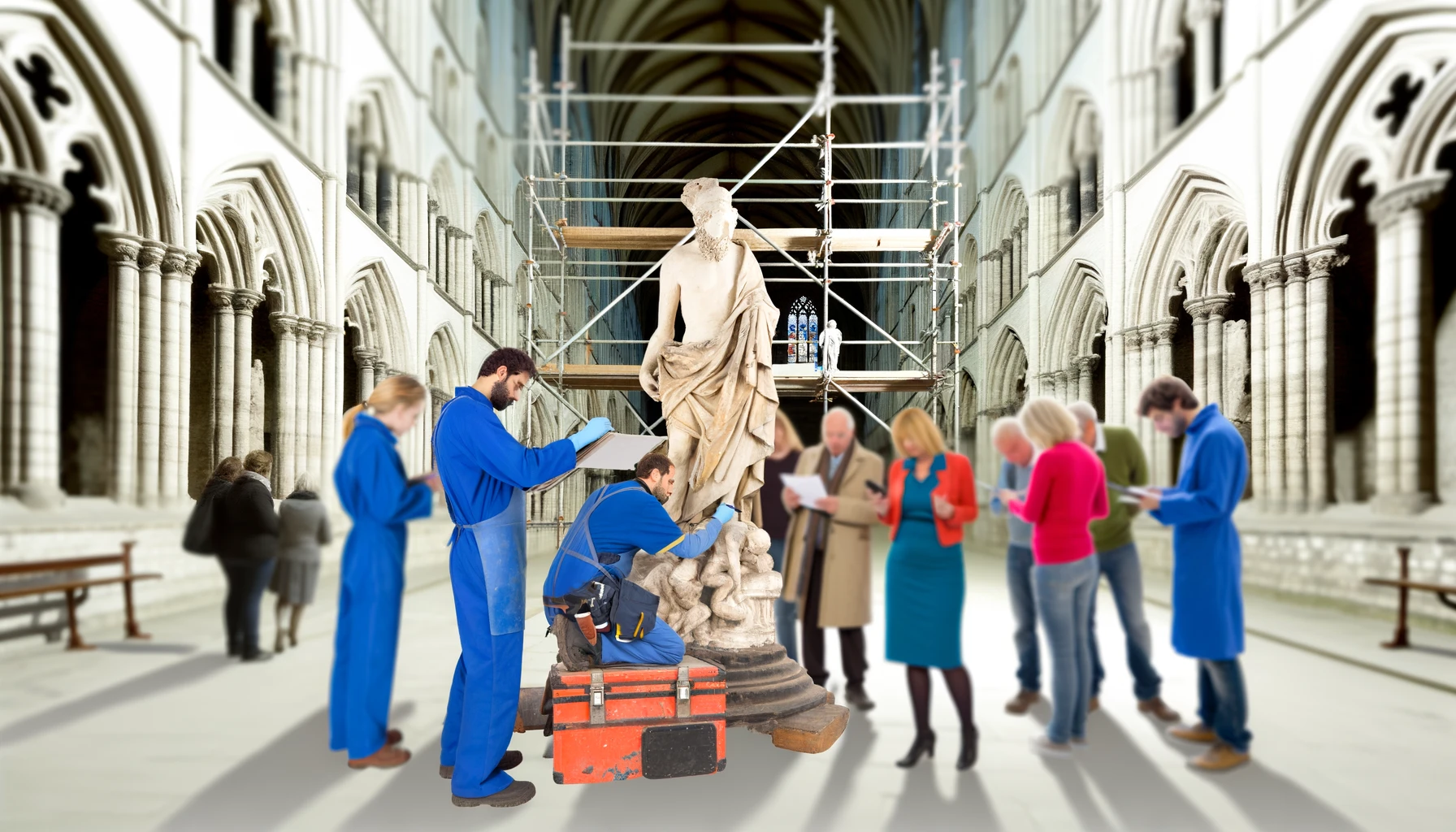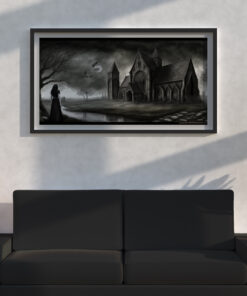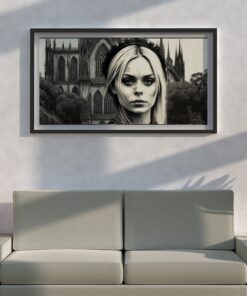
Whispers from the Walls : Beauty in Gothic Art
Gothic Art, an exquisite tapestry woven from the dark threads of the Middle Ages, continues to fascinate and inspire. Its towering cathedrals, intricate sculptures, and luminous stained glass not only embody the artistic genius of the medieval period but also serve as a bridge to a time when faith, beauty, and the macabre intertwined seamlessly in the human experience.
The Historical Context of Gothic Art
Gothic Art, a transformative movement that began in the 12th century, marks a period of profound architectural, artistic, and cultural evolution that spanned the Middle Ages. This section delves into the origins, development, and geographical spread of Gothic Art, setting the stage for its defining characteristics and enduring legacy.
Origins and Evolution
Gothic Art emerged from the Romanesque tradition around the mid-12th century, introducing a new architectural language characterized by heightened structures, light-filled spaces, and an emphasis on verticality and light. Initially manifesting in France, it rapidly spread across Europe, becoming the predominant architectural and artistic style until the 16th century.
- First Gothic Structure: The Abbey Church of Saint-Denis near Paris is often considered the first Gothic building, renovated under Abbot Suger’s direction between 1137 and 1144.
- Notable Developments: The transition from Romanesque to Gothic was marked by technological and aesthetic innovations, facilitating the construction of soaring cathedrals that reached towards the heavens.
Geographic Spread and Influence
Gothic Art’s influence quickly permeated European borders, adapting to local cultures and traditions. This widespread adoption led to diverse regional expressions of the Gothic style, each with unique characteristics yet unified by the foundational elements of Gothic Art.
- England: The introduction of Gothic style to England, evident in the Canterbury Cathedral, saw the adaptation of Gothic elements to English tastes, resulting in the distinctive Perpendicular Gothic style.
- Italy: Italian Gothic, seen in the Florence Cathedral, blended Gothic elements with the existing local artistic tradition, emphasizing more on space and surface decoration.
Key Characteristics of Gothic Art
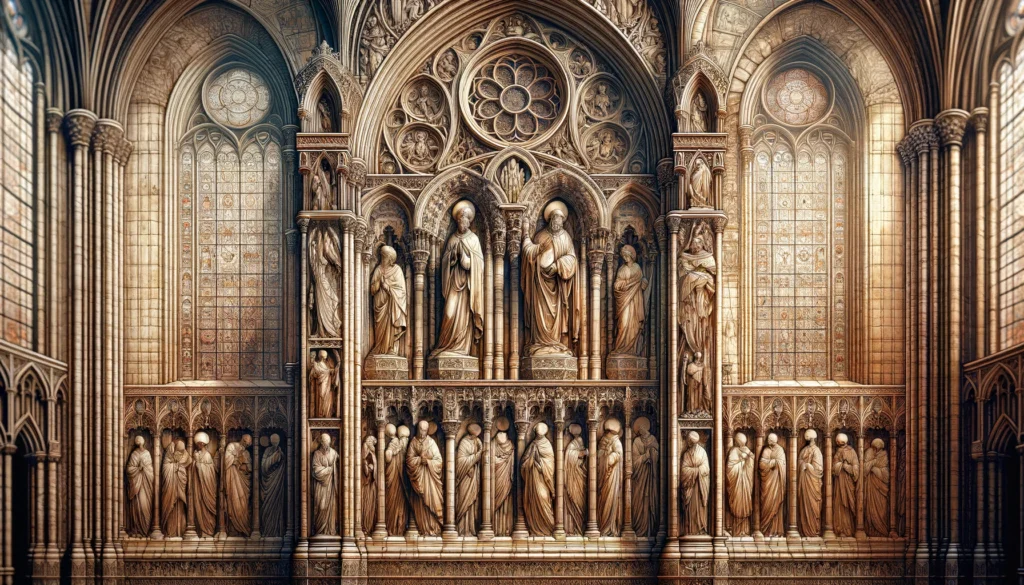
This section explores the architectural innovations and thematic elements that define Gothic Art, illustrating how these features contributed to the creation of spaces that transcended mere physical structures to become embodiments of spiritual aspirations and artistic expression.
Architectural Innovations
The architectural advancements of Gothic Art not only allowed for the construction of structurally sound, towering edifices but also transformed cathedrals into vessels of light and color, profoundly impacting the viewer’s experience.
- Pointed Arches and Ribbed Vaults: These elements enabled the creation of taller structures with complex vaulting, distributing weight more efficiently and allowing for larger windows.
- Flying Buttresses: An external support system that counteracted the outward thrust of the vaults, enabling thinner walls and thus larger windows, which were often filled with stained glass.
Symbolism and Themes
Gothic Art is rich in symbolic content, with each architectural detail, sculpture, and stained glass panel imbued with meaning, reflecting a deep intertwining of faith, art, and the human experience.
- Light as a Symbol of Divine Presence: The innovative use of stained glass windows not only beautified the space but also filled it with color and light, symbolizing divine presence and creating an ethereal atmosphere that connected the earthly with the heavenly.
- Gargoyles and Sculptures: Beyond their functional role as water spouts, gargoyles on Gothic cathedrals served as protectors against evil spirits, while sculptures of saints and biblical narratives served both educational and inspirational purposes.
The Role of Light and Color
The strategic use of light and color was revolutionary in Gothic Art, with stained glass windows playing a pivotal role in shaping the aesthetic and spiritual environment of Gothic cathedrals.
- Stained Glass Artistry: The detailed craftsmanship of stained glass windows narrated stories from the Bible and the lives of saints, casting vibrant colors that enriched the sacred space with visual and symbolic depth.
By understanding these foundational aspects of Gothic Art, one gains insight into the profound impact of this artistic movement on the cultural and spiritual life of the Middle Ages, setting the stage for its lasting influence on subsequent generations of artists and architects.
Explore the depths of darkness and elegance with our curated selection at our Gothic Wall Art.
Masterpieces of Gothic Art
Gothic Art is renowned for its architectural marvels, sculptures, and illuminated manuscripts, each embodying the era’s innovative spirit and deep spiritual fervor. This section explores several iconic works that exemplify the beauty and complexity of Gothic artistry.
Iconic Gothic Cathedrals
- Notre-Dame de Paris: Standing as a testament to the Gothic style’s architectural ambition, Notre-Dame features revolutionary use of flying buttresses, ribbed vaults, and one of the earliest sets of rose windows, which flood its interior with celestial light.
- Chartres Cathedral: Known for housing the Sancta Camisa and its unmatched collection of medieval stained glass, Chartres exemplifies the Gothic blend of architectural ingenuity and spiritual symbolism.
- Milan Cathedral: As one of the largest Gothic cathedrals, it showcases the intricacy of Gothic flamboyant style through its elaborate façade and numerous spires, adorned with statues overlooking the city.
Noteworthy Sculptures and Paintings
- Gargoyles of Notre-Dame: Beyond their architectural function, these sculptures capture Gothic art’s fascination with the grotesque, serving as a reminder of the omnipresence of both divine and demonic forces.
- The Wilton Diptych: A portable altarpiece, represents the religious devotion and artistic sophistication of the late Gothic period, featuring Richard II being presented to the Virgin Mary and Christ surrounded by angels.
The Role of Illuminated Manuscripts
- The Book of Hours: This personal devotional book was popular among the devout of the Gothic period, beautifully illustrated with miniatures and marginalia that reflect the era’s artistic and religious fervor.
Gothic Art’s Influence on Modern and Contemporary Art
-
Gothic Wall Art Bella’s Ethereal Tapestry
$29.99 – $119.99 -
Gothic Wall Art Crimson Temptress
-
Gothic Wall Art Guardian of the Crypt
The echoes of Gothic Art are still felt in various aspects of modern and contemporary art, architecture, and popular culture, demonstrating its timeless appeal and adaptability.
Victorian Gothic Revival Architecture
- The Palace of Westminster: A prime example of Gothic Revival, it incorporates Gothic elements such as pointed arches and elaborate ornamentation, symbolizing national identity and the continuity of tradition in the modern age.
Gothic Elements in Fashion and Design
- Alexander McQueen: His collections often drew inspiration from Gothic motifs, merging them with contemporary design to explore themes of beauty, mortality, and transcendence.
Gothic Influence in Film and Literature
- Horror and Fantasy Genres: Modern horror and fantasy often incorporate Gothic elements, such as the eerie, suspenseful atmosphere and the fascination with the supernatural, seen in works like Tim Burton’s films and J.K. Rowling’s “Harry Potter” series.
By examining the masterpieces of Gothic art and its enduring influence on subsequent artistic movements and contemporary culture, we gain insight into the profound impact of this period on the Western artistic canon. The legacy of Gothic art, with its emphasis on verticality, light, and intricate detail, continues to inspire awe and admiration, reminding us of humanity’s perpetual quest for beauty and meaning.
Exploring the Beauty in Gothic Art
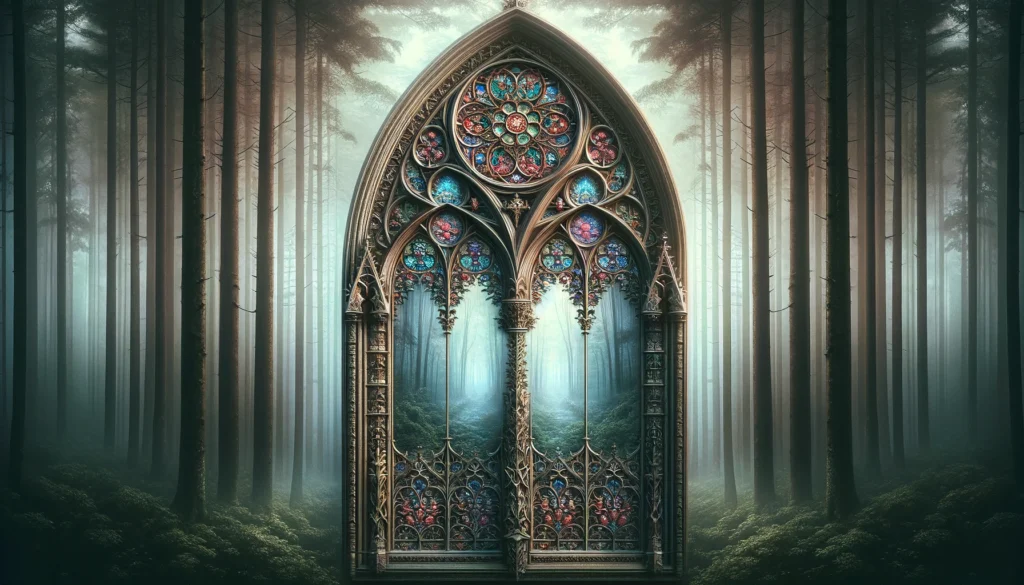
Gothic Art, transcending mere architectural achievement, delves into a realm where darkness and light coalesce, crafting an aesthetic that resonates with the profound depths of human emotion and spiritual longing.
The Aesthetic Appeal of Gothic Art
The allure of Gothic Art lies in its dramatic interplay between shadow and illumination, where the starkness of Gothic sculptures and the vibrancy of stained glass windows create a multisensory experience of divine transcendence. This art form challenges conventional notions of beauty, embracing a complex symbolism where gargoyles and grim facades coexist with the sublime light of its interiors, inviting contemplation and awe.
Emotional and Spiritual Resonance
Gothic cathedrals, with their soaring spires and expansive naves, are designed to elevate the spirit and draw the mind towards contemplation of the divine. The intricate labyrinths found on the floors of many cathedrals, such as Chartres, serve as metaphors for the spiritual journey, guiding the faithful through meditation towards salvation.
Challenging Conventional Notions of Beauty
Gothic Art’s embrace of themes such as mortality, divine judgment, and the sublime challenges viewers to reconsider the nature of beauty. It suggests that true beauty encompasses a range of experiences and emotions, including those that evoke awe, reverence, and even fear.
Preservation and Appreciation of Gothic Art Today
In the contemporary world, the preservation and appreciation of Gothic Art are vital for maintaining a connection to our cultural heritage, offering insights into the medieval worldview and artistic achievements.
Efforts to Preserve Gothic Art
The preservation of Gothic monuments and artworks faces numerous challenges, from environmental degradation to the ravages of time. Notable efforts, such as the ongoing restoration of Notre-Dame de Paris following the 2019 fire, highlight the global commitment to conserving these treasures for future generations. Organizations like UNESCO play a crucial role in these efforts, designating many Gothic sites as World Heritage Sites to ensure their protection and restoration.
Museums and Galleries Showcasing Gothic Art
Institutions around the world, such as The Cloisters in New York City, part of the Metropolitan Museum of Art, dedicate extensive collections to Gothic Art, offering visitors a glimpse into the medieval past through artifacts, sculptures, and illuminated manuscripts. These venues serve as educational resources, fostering an appreciation for the historical and artistic significance of Gothic creations.
Engaging with Gothic Art
For art enthusiasts and travelers, engaging with Gothic Art can be a deeply enriching experience. Virtual tours of Gothic cathedrals and online galleries provide accessible ways to explore these architectural marvels, while academic courses and literature offer deeper insights into their historical context and artistic nuances.
By fostering an appreciation for Gothic Art and its preservation, we ensure that future generations can experience the awe-inspiring beauty and profound spirituality that these works convey, bridging the past and present through a shared cultural legacy.
Conclusion
-
Gothic Wall Art Bella’s Ethereal Tapestry
$29.99 – $119.99 -
Gothic wall art Dracula’s Castle
$29.99 – $119.99 -
Gothic Wall Art Girl
$29.99 – $119.99
The exploration of Gothic Art reveals a rich tapestry of history, symbolism, and profound beauty that transcends time. This art form, originating from the depths of the Middle Ages, continues to captivate and inspire with its intricate details, monumental structures, and the evocative interplay of light and shadow. Gothic Art not only serves as a window into the spiritual and cultural life of the medieval period but also as a testament to humanity’s enduring quest for expression and connection with the divine.
The enduring legacy of Gothic Art is a reminder of the power of artistic innovation to shape our environments, influence subsequent artistic movements, and touch the human soul. As we continue to preserve and appreciate these magnificent works, we not only honor our cultural heritage but also ensure that the whispers from the walls of Gothic cathedrals and the silent gazes of sculpted figures continue to speak to generations to come.
Additional Resources
To further explore the beauty and complexity of Gothic Art, a variety of resources are available for enthusiasts, scholars, and the general public. These resources provide deeper insights into the historical context, artistic achievements, and preservation efforts associated with Gothic Art.
Books and Documentaries
- “The Gothic Enterprise: A Guide to Understanding the Medieval Cathedral” by Robert A. Scott: Offers an in-depth look at the architectural marvels of Gothic cathedrals and the societal forces that shaped them.
- “Gothic: Art for England 1400-1547”: Accompanies an exhibition catalog, providing a comprehensive overview of Gothic Art’s impact on England.
- Documentaries: “The Great Cathedrals” and “Building the Great Cathedrals” offer visual tours and historical insights into the construction and significance of Gothic cathedrals across Europe.
Online Galleries and Virtual Tours
- Google Arts & Culture: Features high-resolution images and virtual tours of Gothic cathedrals and artworks, making it accessible to explore Gothic Art from anywhere in the world.
- The Digital Gothic: An online resource providing access to Gothic architectural drawings, sculptures, and manuscripts, curated by leading universities and museums.
Upcoming Exhibitions and Lectures
- Local Museums and Art Galleries: Keep an eye on the schedules of museums and galleries for temporary exhibitions focused on Gothic Art and related themes.
- Academic Institutions: Universities and colleges often host lectures and seminars on Gothic Art, featuring experts in the field. These events can be invaluable for those looking to deepen their understanding of Gothic themes and techniques.
By engaging with these resources, individuals can enrich their knowledge and appreciation of Gothic Art, fostering a deeper connection to this pivotal period in art history and its lasting influence on culture and society.
